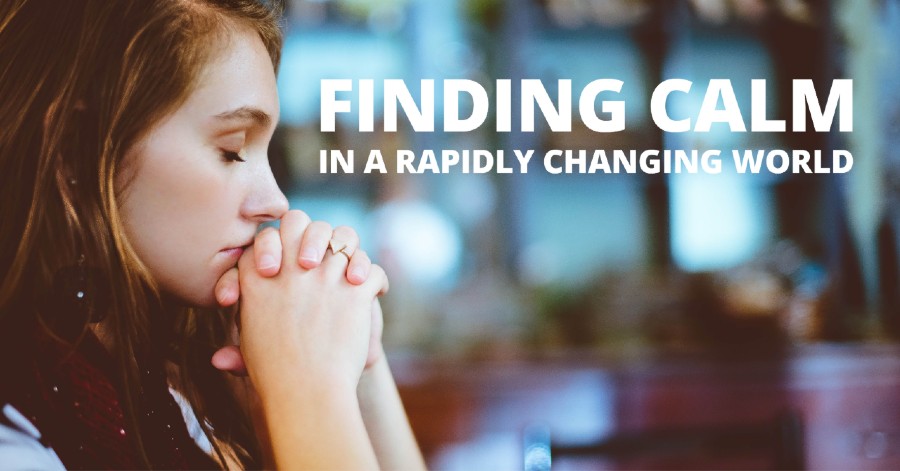
Finding Calm in a Rapidly Changing World
We are going through a period where the future can feel extremely uncertain and big changes are coming at us on a daily basis.
Feelings of anxiety, depression and even panic are normal reactions to these unprecedented circumstances. But while these emotions are perfectly understandable, worry isn’t a helpful state of being. The more we are drawn in to hysteria, the more our lives are impacted and our day-to-day decision-making suffers . In fact, researchers have discovered that feelings of panic can penetrate our prefrontal cortexes and deeply impair our ability to make decisions (1).
While it’s of course not as simple as just switching these feelings off, there are steps we can take to help maintain our mindfulness and composure.
The reported benefits of mindfulness/meditation include lowered stress (2)(3), decreased depression (4) and anxiety (5), improved cognition (6) and more focus (7), making it a practice very worthy of your time.
So, what is mindfulness?
Mindfulness is the ability to be fully present, in tune with where we are and what we’re doing, and not overly reactive or overwhelmed by what’s going on around us. A mindful brain is one that neither lives in the past nor in the future.
The good news is that mindfulness is natural to all of us; we just need to learn how to access this part of our thinking.
Where to begin
Mindfulness is possible in every moment. This can mean longer meditations or simple ‘mindful moment’ practices, like taking time to pause and breathe when there’s a knock on the door instead of running to answer it.
Building mindful habits into our daily lives allows us to put some space between ourselves and our reactions, breaking down our conditioned responses.
This is a simple daily mindfulness technique that also works well if you are feeling a particular moment of stress or worry. Here’s how to begin:
- Schedule some time
You don’t need any special equipment to tune in to mindfulness, but you do need time and space.
- Witness the present
Your goal is not to switch off your mind or reach a state of eternal calm (as nice as it might sound). Instead, observe the present moment as it is, without passing judgment on it.
- Let your judgments wash away
If you notice judgments in your practice, accept it, note it, and let it move on by.
- Revert to witnessing the present moment
It’s easy to get distracted and drawn in to focusing on a thought that enters your head. Mindfulness is the practice of bringing yourself back to the present moment, over and over.
- Be gentle to yourself
Don’t criticise yourself for allowing thoughts to creep in. Just try to be aware when your mind has drifted off, and gently bring it back.
While this may all sound straightforward, it’s not as easy as it sounds. However, with practice, it will become easier. Perseverance is key.
How to incorporate mindfulness into everyday life
Harvard researchers found that, on average, people spend 47% of their waking hours thinking about something other than their current task and that this distraction typically makes them unhappy (8). Here are six ways to seamlessly infuse mindfulness techniques into your daily life
- Waking up
How you start your morning will set the tone for the day ahead. Upon waking, take some time to visualize your ideal day, setting an intention for how you would like the day to go.
It can be something as simple as ‘May things go to plan today’, ‘I want to feel happy and calm throughout the day’ or ‘I hope to stay in tune with my feelings and emotions during this day’. Beginning your day this way creates a conscious plan for how you will think and act.
- Eat aware
Eating your meals mindfully can help you rediscover the pleasure of food. But that’s not the only benefit: research has associated mindful eating with weight loss and improved digestion (9)(10).
As you sit for your meal, switch off the television, leave your mobile in another room and focus on your dining experience. Before you start your meal pause. Look at your food, breathe in the aroma. Eat with small bites, chewing each piece carefully and eating slowly. Take time to enjoy the different sensations, flavours and textures.
- Mindful chores
Transform everyday tasks into mindfulness sessions. Household chores are unavoidable, but by tackling them mindfully, you can turn each task into a mindfulness ritual.
Before putting your next load of freshly washed laundry on the line, let go of any lingering thoughts and make sure you focus fully on the task at hand. Embrace it and don’t rush. Enjoy the freshly washed smell. Look at the designs on each item of clothing. Move with mindfulness as you hang up each item.
Treating simple chores as a mindfulness ritual keeps you in the moment – with you, your space and the world around you all functioning in harmony. By filling this space, there is less room for worries or negative thoughts to flood in and disrupt your mood.
- Mindful movement
Whether it’s walking to the shop or cycling to work, you can turn any waking moment into a mindful one.
Before taking the first step or pedal, focus on your intent. Allow yourself to become aware of the sensation of your stance. Pause. Take a deep breath.
As you begin moving, adjust your limbs slowly and deliberately to support your practice. Observe how the floor or pedals feel beneath your feet. Notice the details in your surroundings – the river flowing, the trees you are passing, the birds singing.
Stay present. Choose to be there for every step.
As we get through coronavirus together, there is an opportunity to make the most of what this rare moment can offer us. We have the time and space to practice finding peace for ourselves and each other. If we can emerge more centred and connected with ourselves, it will be a positive result in a dark time.
In theory, mindfulness can be practised during any activity. The suggestions above should provide inspiration for how you can transform any task into a mindfulness practice. When you experience daily activities as mindful, you can recalibrate your entire way of being to be more present, peaceful and attentive.
References
1) University of Pittsburg (2016). Just made a bad decision? Perhaps anxiety is to blame. [online] ScienceDaily. Available at: http://www.sciencedaily.com/releases/2016/03/160315182709.htm [Accessed 28 Jun. 2020].
2) Goyal, M., Singh, S., Sibinga, E.M.S., Gould, N.F., Rowland-Seymour, A., Sharma, R., Berger, Z., Sleicher, D., Maron, D.D., Shihab, H.M., Ranasinghe, P.D., Linn, S., Saha, S., Bass, E.B. and Haythornthwaite, J.A. (2014). Meditation Programs for Psychological Stress and Well-being. JAMA Internal Medicine, [online] 174(3), p.357. Available at: https://jamanetwork.com/journals/jamainternalmedicine/fullarticle/1809754 [Accessed 7 Jul. 2020].
3) Rosenkranz, M.A., Davidson, R.J., Maccoon, D.G., Sheridan, J.F., Kalin, N.H. and Lutz, A. (2013). A comparison of mindfulness-based stress reduction and an active control in modulation of neurogenic inflammation. Brain, behavior, and immunity, [online] 27(1), pp.174–84. Available at: https://pubmed.ncbi.nlm.nih.gov/23092711/ [Accessed 7 Jul. 2020].
4) Jain, F.A., Walsh, R.N., Eisendrath, S.J., Christensen, S. and Rael Cahn, B. (2015). Critical analysis of the efficacy of meditation therapies for acute and subacute phase treatment of depressive disorders: a systematic review. Psychosomatics, [online] 56(2), pp.140–152. Available at: https://pubmed.ncbi.nlm.nih.gov/25591492/ [Accessed 7 Jul. 2020].
5) Hoge, E.A., Bui, E., Marques, L., Metcalf, C.A., Morris, L.K., Robinaugh, D.J., Worthington, J.J., Pollack, M.H. and Simon, N.M. (2013). Randomized Controlled Trial of Mindfulness Meditation for Generalized Anxiety Disorder. The Journal of Clinical Psychiatry, [online] 74(08), pp.786–792. Available at: https://pmc.ncbi.nlm.nih.gov/articles/PMC3772979/ [Accessed 7 Jul. 2020].
6) Zeidan, F., Johnson, S.K., Diamond, B.J., David, Z. and Goolkasian, P. (2010). Mindfulness meditation improves cognition: Evidence of brief mental training. Consciousness and Cognition, [online] 19(2), pp.597–605. Available at: http://jtoomim.org/brain-training/Zeidan2010_Mindfulness_Meditation.pdf [Accessed 7 Jul. 2020].
7) Kerr, C.E., Sacchet, M.D., Lazar, S.W., Moore, C.I. and Jones, S.R. (2013). Mindfulness starts with the body: somatosensory attention and top-down modulation of cortical alpha rhythms in mindfulness meditation. Frontiers in Human Neuroscience, [online] 7. Available at: https://pmc.ncbi.nlm.nih.gov/articles/PMC3570934/ [Accessed 7 Jul. 2020].
8) Bradt, S. (2010). Wandering mind not a happy mind. [online] Harvard Gazette. Available at: https://news.harvard.edu/gazette/story/2010/11/wandering-mind-not-a-happy-mind/ [Accessed 26 Jun. 2020]
9) Dunn, C., Olabode-Dada, O., Whetstone, L., Thomas, C., Aggarwal, S., Nordby, K., Thompson, S. and Johnson, M. (2018). Mindful Eating and Weight Loss, Results from a Randomized Trial. [online] Available at: https://www.jscimedcentral.com/FamilyMedicine/familymedicine-5-1152.pdf [Accessed 28 Jun. 2020].
10) Cherpak, C.E. (2019). Mindful Eating: A Review Of How The Stress-Digestion-Mindfulness Triad May Modulate And Improve Gastrointestinal And Digestive Function. Integrative Medicine (Encinitas, Calif.), [online] 18(4), pp.48–53. Available at: https://pubmed.ncbi.nlm.nih.gov/32549835/ [Accessed 28 Jun. 2020].


